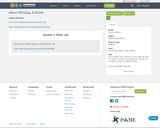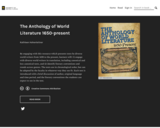
This source discusses the purpose of research writing.
- Subject:
- Composition and Rhetoric
- English Language Arts
- Material Type:
- Textbook
- Provider:
- LibreTexts
- Author:
- Athena Kashyap
- Erika Dyquisto
- Date Added:
- 06/01/2021


This source discusses the purpose of research writing.

1, 2, 3 Write! provides step-by-step instruction to build college writing skills. It combines comprehensive grammar and mechanics review with sentence, paragraph and essay writing techniques and practice. Links to example essays from professional and student writers demonstrate the skills studied and provide reading and critical thinking opportunities.

This collection is intended to provide instructors with a wide variety of nonfiction examples of good writing that they can use to teach composition.

PLEASE NOTE: Some K-12 sites block access to Google Docs where this file resides. If you are unable to access it, it is also available at https://human.libretexts.org/Bookshelves/Literature_and_Literacy/Book%3A_88_Open_Essays_-_A_Reader_for_Students_of_Composition_and_Rhetoric_(Wangler_and_Ulrich)
This book is a free and open resource for composition instructors and students, full of essays that could supplement OER rhetoric and writing texts that lack readings. All of the essays in this reader are versatile rhetorically and thematically. It is arranged alphabetically by author name. Each essay has a series of hashtags that apply to the essay in some way. You can search for essays thematically for topics like education, the environment, politics, or health. You can also search for essays based on composition concepts like analysis, synthesis, and research. You can search for essays that are based on shared values, essays that rely heavily on ethos, logos, or pathos, essays that are very kairos-dependent, and essays that are scholarly.
This collection was created in Google Docs so that it is easily adapted and edited.

This resource includes traditional writing prompts as well as prompts and assignments that utilize AI-generated text. It covers the fields of Creative Writing, Composition, and Business and Technical Writing.

This open booklet is a brief guide to the fundamentals of American Psychological Association (APA) Style 7th edition required for the Education for Academic Purposes (EAP) course and serves as an introductory resource. APA Style for English for Academic Purposes focuses on structure of an APA paper (title page, body, reference page), citations, in-text citations and references.

An inhouse produced workbook that covers the basics of recognising language elements within a given text.

This is one of several resources for ENGL 124. https://openoregon.pressbooks.pub/aboutwriting/

This writer’s reference condenses and covers everything a beginning writing student needs to successfully compose college-level work, including the basics of composition, grammar, and research. It is broken down into easy-to-tackle sections, while not overloading students with more information than they need. Great for any beginning writing students or as reference for advanced students!

Designed specifically for Kwantlen Polytechnic University students, this Pressbook offers interactive activities and strategies for developing academic writing skills. Learners have the opportunity to review key parts of the writing process from interpreting their assignment instructions, organizing their ideas, drafting their writing, and revising their work.

Composition I focuses on principles of writing, critical reading and essay composition using rhetorical styles common in college-level writing (narrative, example/illustration, compare/contrast, cause-and-effect, argument).

This Pressbook is a textbook for Accelerated English. It covers the writing process, writing structure, literary analysis, peer editing workshops, the research process, and narrative essays. It includes practice exam materials, example essays, and a final project and portfolio.

Adaptation of Empoword by Shane Abrams. Link to original text: https://pdxscholar.library.pdx.edu/pdxopen/20/
This adaptation slims down the original by cutting student texts, activities, assignments, and the metacognitive section. Intended for use as a reader.

This text introduces students to reading and writing at the college level and was designed to fulfill the requirements for the Adult Basic Education (ABE) Advanced English Course. This text included examples, exercises, and definitions for many reading- and writing-related topics encountered in college courses.

Practical writing for the world of work. Includes business correspondence to technical reports. Analyze and create written digital products. Focus on understanding the audience for effective communication. Extensive critical reading and writing about workplace texts. Emphasis on fluency in critical writing. Includes research skills and writing a critical, documented report. Prerequisites: ENG101 or 101A or 103 or 136. Reading Proficiency.
COURSE CONTENT:
Writing skills: active verbs, specific details, imperative tone, parallelism, and information literacy
Workplace communication skills: memorandums, business letters, e-mails, blog posts, etc.
Outline development
Graphical integration: instructions, presentations
Technical project skills: research, reports, proposals
Audience and rhetorical situation
Workplace dynamics
Content production and delivery processes
LEARNING OUTCOMES:
Demonstrate practical writing skills for workplace proficiency. (1, 2)
Create digital and written communication documents integrating data. (2)
Use organizational strategies to support the creation of written and digital workplace documents for a variety of purposes. (3)
Write effective instructions incorporating graphics to communicate with peers and clients. (4)
Locate and evaluate information to support workplace documents. (5)
Analyze and interpret information to support workplace documents. (5)
Integrate and document information to support workplace documents. (5)
Analyze the rhetorical situation of digital and written communication to adapt for internal and external audiences; hierarchies and roles; and for psychological, social, cultural, and political factors. (6)
Examine dynamics of organizational psychology in the workplace for the purpose of improving communication. (7)
Analyze written documents, digital content, and oral presentations in order to examine the content production and delivery processes of the workplace writer. (8)

American Literature I (1650–1860) examines significant literary works of early American and Puritan literature, the Enlightenment, American Romanticism, and pre-Civil War era. The course includes primary texts (many accompanied by video/audio options), historical background, literary criticism and interpretation, and instruction on writing about literature.
This course was developed by Anne Eidenmuller from Columbia Basin College with contributing work from Lumen Learning.

This is a resource designed to accompany a course on American Literature II. It has been found to be appropriate for California Community College courses with the following C-ID: ENGL 135

This OER textbook has been developed to support English Composition and Rhetoric courses at rural Arizona community colleges.

This is an anthology of Medieval Literature.

By engaging with this resource which presents texts by diverse world writers from 1650 to the present, learners will: (1) engage with diverse world writers in translation, including canonical and less canonical texts, and (2) identify literary conventions and trends across genres. The texts are in chronological order, but can be adapted by the faculty in whatever way they see fit. Each text is introduced with a brief discussion of author, original language and time period, and the literary conventions the students can expect to see in the text.